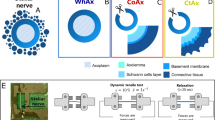Abstract
Biomechanical properties of nerve have been studied extensively. All neural matrix tissues have been suggested to be the main load-bearing component. Based on the ultrastructure it has been proposed that the architecture of the epineurium allows some degree of extensibility of the nerve. A role of the perineurium could be to withstand the positive endoneurial pressure. The hypothesis is that the mechanical behaviour of nerves is dependent on an interaction between the core swelling pressure and restraint by the outer sheath. Loss of this balance will alter that behaviour. To test this, rat sciatic nerves were subjected to mechanical loading at in vivo and ex vivo tension. Retraction of nerve segments was measured after excision and after incubation at 37°C or freezing. Swelling properties of the nerve were measured by immersion in water or PBS (phosphate buffer solution) with intact or opened epineurium. Results showed a significant decrease in strength and stiffness with an increase in strain of the nerve after excision, compared to in vivo. Retraction was on average 11%. Freezing or incubation at 37°C did not alter retraction. The swelling properties of the nerve demonstrated a significant difference between intact and opened epineurium and similar results for water and PBS, indicating that epineurium is a constraint and that the nerves are underhydrated. The proposed model for the intact nerve is a continuous connective tissue tube surrounding and constraining an inner swelling pressure of the neural core. Loss of integrity of the nerve has detrimental effects on its biomechanical properties.






Similar content being viewed by others
References
Brown R, Pedowitz R, Rydevik B, Woo S, Hargens A, Massie J, Kwan M, Garfin SR (1993) Effects of acute graded strain on efferent conduction properties in the rabbit tibial nerve. Clin Orthop Rel Res 288–294
Galbraith JA, Thibault LE, Matteson DR (1993) Mechanical and electrical responses of the squid giant axon to simple elongation. J Biomech Eng 115:13–22
Kwan MK, Wall EJ, Massie J, Garfin SR (1992) Strain, stress and stretch of peripheral nerve. Rabbit experiments in vitro and in vivo. Acta Orthop Scan 63:267–272
Low P, Marchand G, Knox F, Dyck PJ (1977) Measurement of endoneurial fluid pressure with polyethylene matrix capsules. Brain Res 122:373–377
Lundborg G (1970) Ischemic nerve injury. Experimental studies on intraneural microvascular pathophysiology and nerve function in a limb subjected to temporary circulatory arrest. Scand J Plast Reconstr Surg Suppl 6:3–113
Lundborg G (1988a) Intraneural microcirculation. Orthop Clin North Am 19:1–12
Lundborg G (1988b) Nerve injury and repair. Churchill Livingstone, Edinburgh
Lundborg G, Dahlin L (1992) The pathophysiology of nerve compression. Hand Clin 8:215–227
Lundborg G, Dahlin L (1996) Anatomy, function, and pathophysiology of peripheral nerves and nerve compression. Hand Clin 12:185–193
Lundborg G, Rydevik B (1973) Effects of stretching the tibial nerve of the rabbit. A preliminary study of the intraneural circulation and the barrier function of the perineurium. J Bone Joint Surg Br 55:390–401
Lundborg G, Myers R, Powell H (1983) Nerve compression injury and increased endoneurial fluid pressure: a “miniature compartment syndrome”. J Neurol Neurosurg Psychiatry 46:1119–1124
Mackinnon S, Dellon A (1986) Experimental study of chronic nerve compression. Clinical implications. Hand Clin 2:639–650
Mackinnon SE, Dellon AL (1988) Surgery of the peripheral nerve. Thieme, New York
Mackinnon S, Dellon A, Hudson A, Hunter D (1985) A primate model for chronic nerve compression. J Reconstr Microsurg 1:185–195
Mackinnon S, Dellon A, Hudson A, Hunter D (1986a) Chronic human nerve compression—a histological assessment. Neuropathol Appl Neurobiol 12:547–565
Mackinnon S, Dellon A, Hudson A, Hunter D (1986b) Histopathology of compression of the superficial radial nerve in the forearm. J Hand Surg Am 11:206–210
Myers RR, Powell HC, Costello ML, Lampert PW, Zweifach BW (1978) Endoneurial fluid pressure: direct measurement with micropipettes. Brain Res 148:510–515
Rydevik BL, Kwan MK, Myers RR, Brown RA, Triggs KJ, Woo SL, Garfin SR (1990) An in vitro mechanical and histological study of acute stretching on rabbit tibial nerve. J Orthop Res 8:694–701
Stolinski C (1995) Structure and composition of the outer connective tissue sheaths of peripheral nerve. J Anat 186:123–130
Sunderland S (1981) Stretch-compression neuropathy. Clin Exp Neurol 18:1–13
Ushiki T, Ide C (1990) Three-dimensional organization of the collagen fibrils in the rat sciatic nerve as revealed by transmission and scanning electron microscopy. Cell Tissue Res 260:175–184
Wall EJ, Kwan MK, Rydevik BL, Woo SL, Garfin SR (1991) Stress relaxation of a peripheral nerve. J Hand Surg 16:859–863
Wall EJ, Massie JB, Kwan MK, Rydevik BL, Myers RR, Garfin SR (1992) Experimental stretch neuropathy. Changes in nerve conduction under tension. J Bone Joint Surg 74:126–129
Acknowledgements
We are grateful to Ms. R. Porter, Dr. T. Luijsterburg and Mr. I. Khan for their “graphical” help.
Author information
Authors and Affiliations
Corresponding author
Additional information
Preliminary forms of this project were presented at the 1st UK Tissue & Cell Engineering Society meeting, Hammersmith Hospital, RPMS, London, 5 July 1999, and at the 7th FESSH, Barcelona, Spain, 22 June 2000. Support was partly given by EU grant QLK3-CT-1999-00625: NEURO-TEC
Rights and permissions
About this article
Cite this article
Walbeehm, E.T., Afoke, A., de Wit, T. et al. Mechanical functioning of peripheral nerves: linkage with the “mushrooming” effect. Cell Tissue Res 316, 115–121 (2004). https://doi.org/10.1007/s00441-004-0867-9
Received:
Accepted:
Published:
Issue Date:
DOI: https://doi.org/10.1007/s00441-004-0867-9




